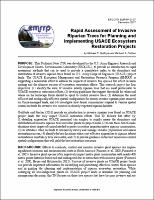Please use this identifier to cite or link to this item:
https://hdl.handle.net/11681/25941Full metadata record
| DC Field | Value | Language |
|---|---|---|
| dc.contributor.author | Guilfoyle, Michael P. | en_US |
| dc.contributor.author | Fischer, Richard A., Jr., 1964- | en_US |
| dc.creator | Environmental Laboratory (U.S.) | en_US |
| dc.creator | Ecosystem Management and Restoration Research Program (U.S.) | en_US |
| dc.date.accessioned | 2017-12-27T14:19:03Z | en_US |
| dc.date.available | 2017-12-27T14:19:03Z | en_US |
| dc.date.issued | 2017-12 | en_US |
| dc.identifier.govdoc | ERDC/TN EMRRP-SI-37 | en_US |
| dc.identifier.uri | http://hdl.handle.net/11681/25941 | en_US |
| dc.identifier.uri | http://dx.doi.org/10.21079/11681/25941 | en_US |
| dc.description | Technical Note | en_US |
| dc.description.abstract | This Technical Note (TN) was developed by the U.S. Army Engineer Research and Development Center- Environmental Laboratory (ERDC-EL), to provide an introduction to rapid assessment methods that can be used to provide a quantitative index to the abundance and distribution of invasive riparian trees found on U.S. Army Corps of Engineers (USACE) project lands. The USACE Ecosystem Management and Restoration Research Program (EMRRP) is supporting a nationwide effort to address the impacts of invasive tree species that affect decision making and the ultimate success of ecosystem restoration efforts. This research project has four objectives: (1) identify the suite of invasive woody riparian trees that are most problematic to USACE ecosystem restoration efforts, (2) develop guidelines that suggest thresholds for when and where on the landscape funds should be spent to control invasive trees, (3) determine the most efficient and ecologically-effective spatial configuration for woody invasive riparian plant removal on Corps-managed lands, and (4) investigate how faunal communities respond to various spatial control methods for invasive tree removal in densely vegetated riparian habitats. Guilfoyle and Fischer (2016) provide an introduction to invasive riparian trees found on USACE project lands that may impact USACE restoration efforts. This TN follows that effort by: (1) detailing approaches USACE personnel can employ to rapidly assess the abundance and distribution of invasive riparian trees and other plants on project lands, (2) to use these data to make decisions about degree of control needed to protect or restore important native riparian communities, (3) to introduce other methods to intensively survey and manage invasive populations and assess restoration success, (4) identify the best locations where cost-effective approaches to riparian habitat restoration is most likely to be successful, and (5) to provide guidance on the best removal or control spatial configurations that will yield the best restoration outcomes. | en_US |
| dc.description.sponsorship | Ecosystem Management and Restoration Research Program (U.S.) | en_US |
| dc.format.extent | 11 pages/1.20 MBs | en_US |
| dc.format.medium | PDF/A | en_US |
| dc.language.iso | en_US | en_US |
| dc.publisher | Engineer Research and Development Center (U.S.) | en_US |
| dc.relation.ispartofseries | Technical Note (Ecosystem Management and Restoration Research Program (U.S.)) ; no. ERDC/TN EMRRP-SI-37 | en_US |
| dc.rights | Approved for public release; distribution is unlimited | en_US |
| dc.source | This Digital Resources was created in Microsoft Word and Adobe Acrobat | en_US |
| dc.subject | Riparian plants | en_US |
| dc.subject | Invasive plants | en_US |
| dc.subject | Restoration ecology | en_US |
| dc.title | Rapid assessment of invasive riparian trees for planning and implementing USACE ecosystem restoration projects | en_US |
| dc.type | Report | en_US |
| Appears in Collections: | Technical Note | |
Files in This Item:
| File | Description | Size | Format | |
|---|---|---|---|---|
| ERDC-TN EMRRP-SI-37.pdf | 1.24 MB | Adobe PDF |  View/Open |